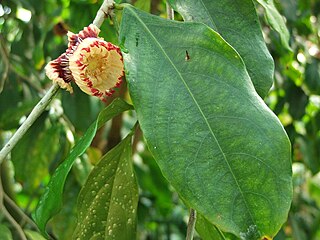
The French Congo or Middle Congo was a French colony which at one time comprised the present-day area of the Republic of the Congo, Gabon, and the Central African Republic.

Panda is a plant genus of the family Pandaceae. It contains only one known species, Panda oleosa, native to western and central Africa.
Dichostemma is a flowering plant genus in the family Euphorbiaceae first described as a genus in 1896. It is native to tropical western and central Africa.
- Dichostemma glaucescensPierre - Nigeria, Cameroon, Gabon, Congo, Central African Republic, Cabinda, Zaire
- Dichostemma zenkeriPax - Cameroon

Synsepalum is a genus of trees and shrubs in the chicle family, Sapotaceae described as a genus in 1852.

Napoleonaea is a genus of woody plant in the family Lecythidaceae first described as a genus in 1804, the same year its namesake crowned himself Emperor of the French. The genus is native to Africa.
Lecomtedoxa is a genus of plant in family Sapotaceae described as a genus in 1914.
Pausinystalia is a largely African genus of plant in the family Rubiaceae. As of the present time Pausinystalia contains the following 5 species:
Tieghemella is a genus of the plant family Sapotaceae described as a genus in 1890. The wood of Tieghemella species is known as makore in the lumber trade.
Rhopalopilia is a genus of plants in the family Opiliaceae described as a genus in 1896.
Guaduella is a genus of African plants in the grass family, the only genus in the tribe Guaduellieae. It belongs to the subfamily Puelioideae, one of the early-diverging lineages in the grasses, but used to be included in the bamboos.
- Guaduella densifloraPilg. - Nigeria, Cabinda, Cameroon, Republic of Congo, Gabon, Equatorial Guinea
- Guaduella dichroaCope - Cabinda
- Guaduella humilisClayton - Nigeria, Cameroon
- Guaduella macrostachys(K.Schum.) Pilg. - Ghana, Nigeria, Cameroon, Gabon
- Guaduella marantifoliaFranch. - Cameroon, Republic of Congo, Gabon
- Guaduella oblongaHutch. ex Clayton - Guinea, Sierra Leone, Ivory Coast, Cameroon, Republic of Congo, Gabon, São Tomé, Bioko
Atractogyne is a genus of flowering plants in the family Rubiaceae. It is found in western and western-central tropical Africa.
Craterispermum is a genus of flowering plants in the family Rubiaceae. It contains 16 species that occur in tropical Africa and Seychelles. It is the only genus in the tribe Craterispermeae, of which the divergence time is estimated at 34.8 million years ago.

Englerophytum is a group of trees in the family Sapotaceae described as a genus in 1914.
Crioceras is a plant genus in the family Apocynaceae first described as a species in 1897. It contains only one known species, Crioceras dipladeniiflorus, native to tropical central Africa.
Cylindropsis is a genus of plants first described in 1898. It contains only one known species, Cylindropsis parvifolia , native to central Africa.
Dewevrella is a genus of plants first described in 1907. It contains only one known species, Dewevrella cochliostema , native to central Africa.
Dictyophleba is a genus of flowering plants in the family Apocynaceae first described as a genus in 1898. It is native to Africa and to the Comoros Islands in the Indian Ocean.
- Dictyophleba leonensis(Stapf) Pichon - West Africa from Cameroon to Liberia
- Dictyophleba lucida(K.Schum.) Pierre - Comoros, central + southern Africa from Nigeria east to Tanzania and south to Zimbabwe
- Dictyophleba ochracea(K.Schum. ex Hallier f.) Pichon - central Africa from Nigeria to Zaire
- Dictyophleba rudensHepper - Cameroon
- Dictyophleba setosaB.de Hoogh - Cameroon, Gabon
- Dictyophleba stipulosa(S.Moore ex Wernham) Pichon - from Ivory Coast to Congo-Brazzaville
Farquharia is a genus of flowering plants in the family Apocynaceae, first described as a genus in 1912. It contains only one recognized species, Farquharia elliptica, native to tropical western and central Africa.
Orthopichonia is a genus of plants in the family Apocynaceae, first described as a genus in 1953. It was initially given the name Orthandra, but this turned out to be an illegitimate homonym. Orthopichonia is native to Africa.
Delpydora is a genus of plant in the family Sapotaceae described as a genus in 1897.





